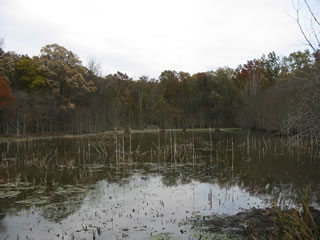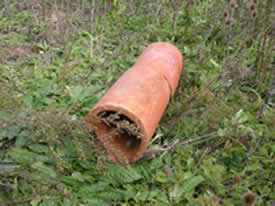|
 Wetland
Destruction Wetland
Destruction
A wetland is an area of land that is either saturated
or flooded a majority of the time and supports vegetation
that can withstand an extremely moist environment. (See "Wetlands"
for more information.)
Wetland destruction has become a major environmental
issue in the United States, as nearly half of the wetlands
in the lower forty-eight states have been destroyed. More
than 85% of Indiana’s wetlands have been eliminated
since the 1800s, and many forested wetlands have been lumbered
for their high-value hardwood. More than five million acres
of wetlands used to exist in the state, but just over 800,000
acres remain today. These wetlands were extensively "tiled"
during the 1800s—that is, the land was drained for agriculture
by laying rows of large, ceramic drainage pipes several feet
under the ground (today, plastic is used). By 1882, more than
30,000 miles of drainage tiles had been installed in Indiana.
 |
A
drainage tile used to
remove water from farm fields. |
To restore wetlands that have been altered in
this manner, the main drainage line is removed where it feeds
into the ditch, then both ends are filled with concrete. The
lateral tiles can be left in place. This allows the water
to naturally flood the land.
With the loss of wetlands has come the loss of
valuable habitat for Indiana’s native species. More
than one-third of the species listed under the Endangered
Species Act are dependent on wetlands for some part of
their life. It has been estimated that in the United States,
roughly 150 species of birds (such as the great blue heron,
bald eagle, and belted kingfisher) and more than 200 species
of fish depend on wetlands for their survival. Mammals, like
the muskrat and white-tailed deer, and a variety of reptiles,
amphibians, and invertebrates all rely on wetlands. Wetlands
exceed all other land types in wildlife productivity, and
the disruption or destruction of a wetland direct disrupts
or destroys the animals that live there.
The loss of wetlands also leads to flooding and
decreased quality of water in lakes, rivers, and tributaries.
Wetlands serve as both nature's sponge and filter, absorbing
excess water and cleaning the chemicals, sediments, and excess
nutrients that enter the surface water. When wetlands are
destroyed, these functions are no longer performed.
Wetlands play a significant role in Indiana’s
environment. Yet, to date, Indiana does not have any laws
to protect them. As noted in a Muncie, Indiana, newspaper,
"IDEM's [Indiana Department of Environmental Management's]
attempts to get rules adopted to protect wetlands have met
opposition from Indiana Farm Bureau, Indiana Manufacturers
Association, Indiana Builders Association, utility companies,
steel companies, local government, waste management firms
and others" (Slabaugh). Until onlookers realize that
wetlands are not a waste of land or a mosquito trap, this
valuable ecosystem remains at risk in Indiana.
Sources:
Dahl, Thomas E., and Gregory J. Allord.
"History of Wetlands in the Conterminous United States."
National Water Summary on Wetland Resources. 9 Feb.
1999. U.S. Geological Survey. 30 Nov. 2002. <http://water.usgs.gov/nwsum
/WSP2425/history.html>.
Sanders, Scott Russell. "The
Care and Feeding of Wetlands." Audubon Magazine May-June
2001. 15 Oct. 2002 <http://magazine.audubon.org/
features0105/limberlost.html#care>.
Slabaugh, Seth. "Wetlands Valuable,
But Unprotected." The Star Press 21 Nov. 2002.
30 Nov. 2002. <http://thestarpress.com/tsp/news/local/02/nov/
1121wetlandsnewswithbreakoutatbottom.php>.
State of Indiana. Dept. of Natural
Resources. Fish and Wildlife Conservation. "The Status
of Wetlands in Indiana." Indiana Wetland's Conservation
Plan Apr. 1996. 15 Oct. 2002 <http://www.in.gov/dnr/fishwild/publications/
inwetcon/status.pdf>.
United States. Dept. of Agriculture.
Natural Resources Conservation Service. Indiana Wetlands
Reserve Program. By Gerald Roach. 8 Dec. 2000. 15 Oct.
2002 <http://www.nrcs.usda.gov/programs/wrp/states/in.html>.
|




